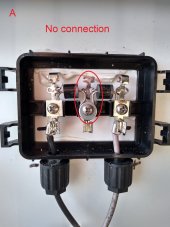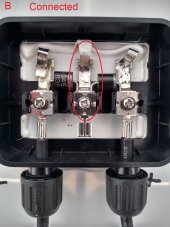I have two 100W panels from the same manufacturer with the same part # that are wired differently in the panel’s junction box. Panels were purchased about one year apart.
Panel B has the center connection connected to a trace on the panel whereas panel A does not. Panel A does not have a similar trace. (All of the panels I own from other manufacturers are similar to panel B.)
I noticed this past summer that panel A’s output reduced. After examining connections and other system components, I concluded that the bypass diodes might be damaged on panel A, so I replaced them a few weeks ago with exact replacements. There was no change in the output. Unfortunately during the summer I did not document the reduction, but when I swap the panels, panel B is working as it should. (My point is that panel A may not have worked properly from the day of installation.)
IMO, panel A does not need two diodes as the center connection is not connected to anything.
It’s been cloudy where I live the past six days, so I have not had a chance to experiment.
I looking for guidance on this issue.
Panel B has the center connection connected to a trace on the panel whereas panel A does not. Panel A does not have a similar trace. (All of the panels I own from other manufacturers are similar to panel B.)
I noticed this past summer that panel A’s output reduced. After examining connections and other system components, I concluded that the bypass diodes might be damaged on panel A, so I replaced them a few weeks ago with exact replacements. There was no change in the output. Unfortunately during the summer I did not document the reduction, but when I swap the panels, panel B is working as it should. (My point is that panel A may not have worked properly from the day of installation.)
IMO, panel A does not need two diodes as the center connection is not connected to anything.
It’s been cloudy where I live the past six days, so I have not had a chance to experiment.
I looking for guidance on this issue.




